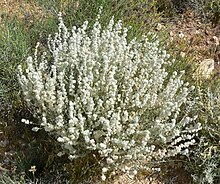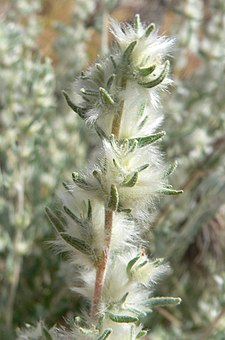
Ambrosia dumosa, the burro-weed or white bursage, a North American species of plants in the family Asteraceae. It is a common constituent of the creosote-bush scrub community throughout the Mojave desert of California, Nevada, and Utah and the Sonoran Desert of Arizona and northwestern Mexico.

Baccharis pilularis, called coyote brush, chaparral broom, and bush baccharis, is a shrub in the family Asteraceae native to California, Oregon, Washington, and Baja California. There are reports of isolated populations in New Mexico, most likely introduced.

Eriogonum fasciculatum is a species of wild buckwheat known by the common names California buckwheat and flat-topped buckwheat. Characterized by small, white and pink flower clusters that give off a cottony effect, this species grows variably from a patchy mat to a wide shrub, with the flowers turning a rusty color after blooming. This plant is of great benefit across its various habitats, providing an important food resource for a diversity of insect and mammal species. It also provides numerous ecosystem services for humans, including erosion control, post-fire mitigation, increases in crop yields when planted in hedgerows, and high habitat restoration value.

Ratibida columnifera, commonly known as upright prairie coneflower, Mexican hat, and longhead prairie coneflower, is a perennial species of flowering plant in the genus Ratibida in the family Asteraceae. It is native to much of North America and inhabits prairies, plains, roadsides, and disturbed areas from southern Canada through most of the United States to northern Mexico.
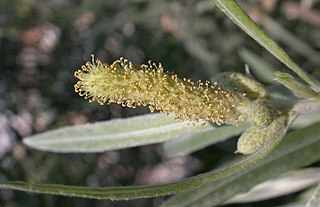
Salix exigua is a species of willow native to most of North America except for the southeast and far north, occurring from Alaska east to New Brunswick, and south to northern Mexico. It is considered a threatened species in Massachusetts while in Connecticut, Maryland, and New Hampshire it is considered endangered.
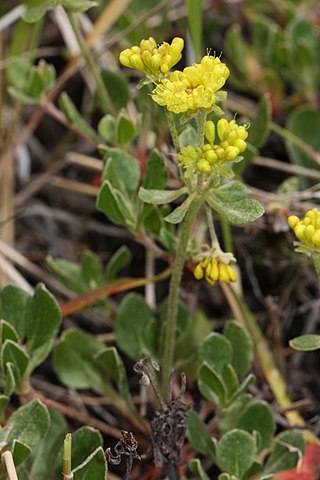
Eriogonum umbellatum is a species of wild buckwheat known by the common name sulphurflower buckwheat, or simply sulphur flower. It is native to western North America from California to Colorado to central Canada, where it is abundant and found in many habitats, including the sagebrush steppe and alpine areas. It is an extremely variable plant and hard to identify because individuals can look very different from one another. Also, there are many varieties. It may be a perennial herb blooming by summer with stems 10 centimeters tall and two to six clusters of flowers, with a whorl of leaves below the stems, or a sprawling shrub approaching two meters high and wide. The leaves are usually woolly and low on the plant, and the flowers come in many colors from white to bright yellow to purple.
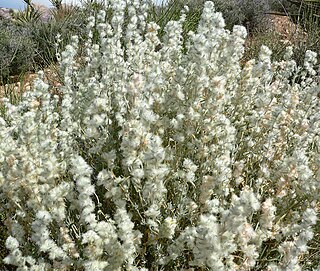
Krascheninnikovia is a genus of flowering plants in the subfamily Chenopodioideae of the family Amaranthaceae known as winterfat, so-called because it is a nutritious livestock forage. They are known from Eurasia and western North America. These are hairy perennials or small shrubs which may be monoecious or dioecious. They bear spike inflorescences of woolly flowers.
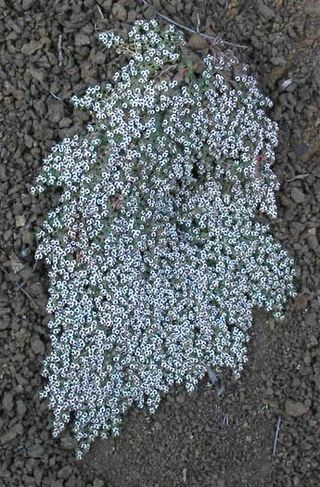
Euphorbia polycarpa is a species of spurge known by the common name smallseed sandmat. It is native to the southwestern United States and northern Mexico, especially the deserts and other dry, sandy areas. This is a perennial herb producing stems that trail along the ground to form a clump or mat, sometimes growing somewhat upright. The leaves are each under a centimeter long. They are round or oval-shaped and have triangular stipules at the bases. What looks like a single flower is actually an inflorescence of many staminate (male) flowers united around a single central pistillate (female) flower. Bracts surrounding the flower unit are white and petal-like. The fruit is a thin spherical capsule less than 2 millimeters wide layered over a seed.

Ambrosia eriocentra is a North American species of ragweed known by the common names woolly bursage and woollyfruit burr ragweed.

Astragalus purshii is a species of milkvetch known by the common names woollypod milkvetch and Pursh's milkvetch.
Bernardia myricifolia is a species of flowering plant in the spurge family known by the common name mouse's eye. It is also called mouse ear, or oreja de ratón in Spanish. It is native to Texas, New Mexico, and Mexico. It grows in shrub communities on rocky, limestone hills. This is a perennial shrub growing over three meters in maximum height. The small leaves are each up to three centimeters long, oval in shape, with scallop-shaped teeth along the edges. A dioecious species, male and female individuals produce different types of flowers. Staminate inflorescences are small clusters of male flowers, and pistillate inflorescences bear solitary female flowers. The fruit is a roughly rounded woolly capsule with three prominent chambers, each containing a seed.

Euphorbia schizoloba is a species of euphorb known by the common name Mojave spurge. It is native to the southwestern United States, where it grows in desert hills and mountains. It is a perennial herb producing upright stems up to 40 centimeters tall, sometimes with coats of sparse hairs. The stems are lined with alternately arranged leaves which are oval with pointed tips and measure up to 2 centimeters in length. The inflorescence is a cyathium with bell-shaped bracts surrounding four tiny glands with flat, fringed appendages. At the center of this arrangement are several staminate flowers and one long pistillate flower.

Dieteria canascens is an annual plant or short lived perennial plant in the family Asteraceae, known by the common names hoary tansyaster and hoary-aster.

Rhus aromatica, the fragrant sumac, is a deciduous shrub in the family Anacardiaceae native to North America. It is found in southern Canada and nearly all of the lower 48 states except peninsular Florida.

Tetracoccus hallii is a species of flowering shrub in the family Picrodendraceae, known by the common names Hall's shrubby-spurge and Hall's tetracoccus.
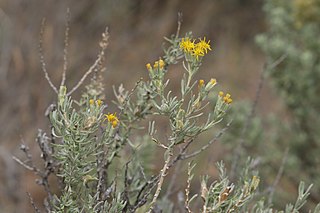
Tetradymia argyraea is a species of flowering plant in the aster family known by the common names spineless horsebrush and gray horsebrush. It is native to western North America.
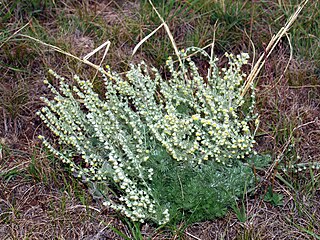
Artemisia frigida is a widespread species of flowering plant in the aster family, which is known as the sunflower family. It is native to Europe, Asia, and much of North America. In parts of the north-central and northeastern United States it is an introduced species.

Artemisia pedatifida is a species of flowering plant in the aster family known by the common names birdfoot sagebrush and matted sagewort. It is native to a section of the west-central United States encompassing parts of Idaho, Montana, Wyoming and Colorado, where it occurs on the high plains.

Lycium pallidum is a species of flowering plant in the nightshade family known by the common names pale wolfberry and pale desert-thorn. It is native to northern Mexico and the southwestern United States. In Mexico it can be found in Sonora, Chihuahua, Zacatecas, and San Luis Potosi. In the United States it occurs from California to Texas and as far north as Utah and Colorado.

Krascheninnikovia ceratoides, the Pamirian winterfat, is a plant species native to Central Europe and Southern Europe, North Africa, and parts of Asia. It has been reported from Russia, China, Mongolia, Pakistan, Kazakhstan, Uzbekistan, Iran, Afghanistan, Ukraine, Egypt, Morocco, Spain, Austria, Slovakia, Czech Republic, and Romania.
